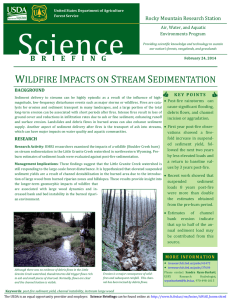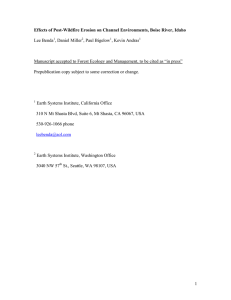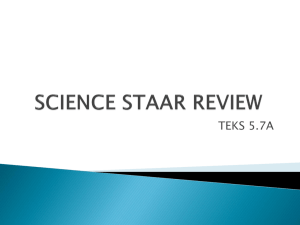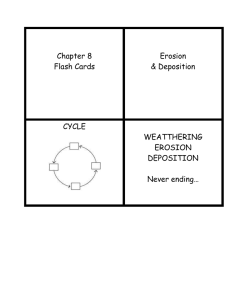Document 12951135
advertisement
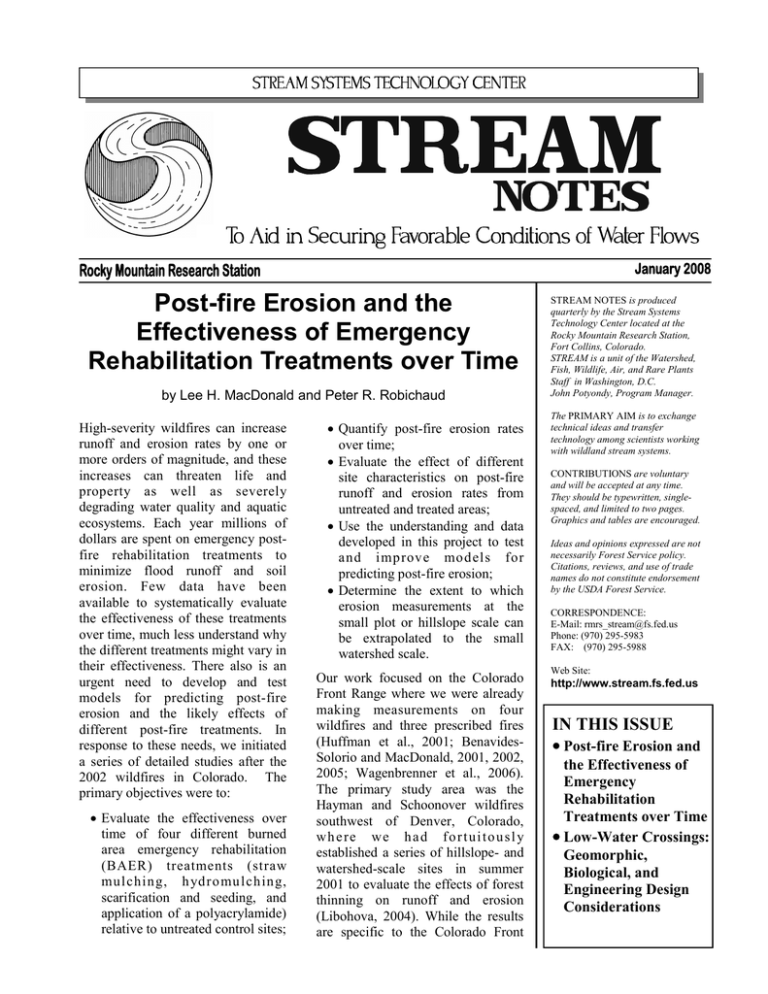
Post-fire Erosion and the Effectiveness of Emergency Rehabilitation Treatments over Time by Lee H. MacDonald and Peter R. Robichaud High-severity wildfires can increase runoff and erosion rates by one or more orders of magnitude, and these increases can threaten life and property as well as severely degrading water quality and aquatic ecosystems. Each year millions of dollars are spent on emergency postfire rehabilitation treatments to minimize flood runoff and soil erosion. Few data have been available to systematically evaluate the effectiveness of these treatments over time, much less understand why the different treatments might vary in their effectiveness. There also is an urgent need to develop and test models for predicting post-fire erosion and the likely effects of different post-fire treatments. In response to these needs, we initiated a series of detailed studies after the 2002 wildfires in Colorado. The primary objectives were to: • Evaluate the effectiveness over time of four different burned area emergency rehabilitation (BAER) treatments (straw mulching, h ydro mu lching, scarification and seeding, and application of a polyacrylamide) relative to untreated control sites; • Quantify post-fire erosion rates over time; • Evaluate the effect of different site characteristics on post-fire runoff and erosion rates from untreated and treated areas; • Use the understanding and data developed in this project to test and improve models for predicting post-fire erosion; • Determine the extent to which erosion measurements at the small plot or hillslope scale can be extrapolated to the small watershed scale. Our work focused on the Colorado Front Range where we were already making measurements on four wildfires and three prescribed fires (Huffman et al., 2001; BenavidesSolorio and MacDonald, 2001, 2002, 2005; Wagenbrenner et al., 2006). The primary study area was the Hayman and Schoonover wildfires southwest of Denver, Colorado, w h e re we h a d f o r t u i t o u s l y established a series of hillslope- and watershed-scale sites in summer 2001 to evaluate the effects of forest thinning on runoff and erosion (Libohova, 2004). While the results are specific to the Colorado Front STREAM NOTES is produced quarterly by the Stream Systems Technology Center located at the Rocky Mountain Research Station, Fort Collins, Colorado. STREAM is a unit of the Watershed, Fish, Wildlife, Air, and Rare Plants Staff in Washington, D.C. John Potyondy, Program Manager. The PRIMARY AIM is to exchange technical ideas and transfer technology among scientists working with wildland stream systems. CONTRIBUTIONS are voluntary and will be accepted at any time. They should be typewritten, singlespaced, and limited to two pages. Graphics and tables are encouraged. Ideas and opinions expressed are not necessarily Forest Service policy. Citations, reviews, and use of trade names do not constitute endorsement by the USDA Forest Service. CORRESPONDENCE: E-Mail: rmrs_stream@fs.fed.us Phone: (970) 295-5983 FAX: (970) 295-5988 Web Site: http://www.stream.fs.fed.us IN THIS ISSUE • Post-fire Erosion and the Effectiveness of Emergency Rehabilitation Treatments over Time • Low-Water Crossings: Geomorphic, Biological, and Engineering Design Considerations Range, we believe that the underlying principles are much more broadly applicable and should be of considerable interest to resource managers, scientists, and modelers. Effectiveness of Different BAER Treatments To evaluate the effectiveness of the different BAER treatments (straw mulching, hydromulching, scarification and seeding, and application of a polyacrylamide), we established 18 pairs of treated and control hillslopes plus four nearby hillslopes that had been treated with aerial hydromulching. Eroded sediment was captured and measured at each site with sediment fences (fig. 1). Most of the control sites were established within several weeks after burning in summer 2002, and the treatments were applied within 1-3 months after burning. All sites had burned at high severity, and they have been monitored through summer 2007. Rainfall simulations in the field and in the laboratory allowed more controlled studies of treatment effectiveness and the underlying runoff and erosion processes. A series of lab experiments also were conducted to test whether the polyacrylamide (PAM) preferentially binds with mineral soil and/or ash in aqueous solutions. Both the hillslope data and the rainfall simulations showed that the straw mulch and aerial hydromulch significantly increased the amount of ground cover and reduced post-fire erosion rates (Rough, 2007; Schaffrath, in prep.). More specifically, both of these treatments reduced sediment yields by more than 90% from the time of initial application in late summer 2002 through summer 2003, and in summer 2004 they reduced sediment yields by 77% and 50%, respectively. By summer 2005 there were no significant differences in ground cover or sediment yields between the treated and control sites because: (1) the mulch cover had decayed or been eroded and (2) vegetative regrowth had progressively eliminated the differences in ground cover between the treated and the control sites. In contrast to the aerial hydromulch treatment, which significantly reduced sediment yields in the first two summers after burning, the ground-based hydromulch treatment had no significant effect on hillslope-scale sediment yields. Visual observations Figure 1. Photo from summer 2003 showing a pair of sediment fences, the piles of sediment excavated from the fences, and the relatively bare hillslopes after the June 2002 Hayman fire. indicated that aerial hydromulch yielded a stronger and more cohesive surface cover than the groundbased hydromulch, and this is attributed to its lower water content, higher wood fiber content, and inclusion of a PAM binding agent. The aerial hydromulch treatment also was applied more uniformly and had a higher seed density (Rough, 2007; Schaffrath, in prep.). Since a nearby aerial hydromulch application did not significantly reduce sediment yields at the small watershed scale, additional studies are needed to assess how the formulation and application of hydromulch affects its ability to reduce post-fire erosion under varying site conditions and storm events. The scarification and seeding treatment had no significant effect on either vegetative regrowth or post-fire sediment yields (Rough, 2007; Schaffrath, in prep.). Field measurements showed that the mean depth of scarification using McLeod hand tools was only about 2-3 cm, and this was neither sufficiently deep nor extensive enough to break up the fire-induced soil water repellency (Rough, 2007). Qualitative field observations indicate that scarifying with harrows behind all-terrain vehicles also was ineffective, as there was surface rilling and no visual evidence of increased plant cover relative to adjacent untreated areas. Our sediment production data and other studies suggest that the scarification may have increased post-fire erosion by about 50% by disturbing the soil surface, but this increase was not statistically significant due to the high variability between sites (Rough, 2007). Post-fire Erosion and Recovery for Untreated Sites To quantify post-fire erosion rates over time, we established and/or continued monitoring 63 untreated control sites on four wildfires and one prescribed fire. These data were combined with our pre-existing data from seven wildfires and three prescribed fires to yield 422 plot-years of data from 110 hillslopes that had burned at varying severities. We also conducted rainfall simulation experiments in the third year after burning on the 2000 Bobcat wildfire and in the second and third years after burning on the Hayman wildfire. The majority of our study sites were in areas that had burned at high severity, as our previous work had shown that these areas generate nearly an order of magnitude more sediment than sites burned at moderate or low severity (Benavides-Solorio and MacDonald, 2001, 2002, 2005). Sediment production rates from sites burned at high-severity generally approach background rates by the third summer or roughly 24 months after burning (fig. 2) (Benavides-Solorio and 40 Sediment yield (Mg ha-1 yr-1) The application of dry and wet PAM on hillslopes had little or no effect on post-fire erosion rates as these did not increase the amount of ground cover or increase vegetative regrowth relative to the adjacent control sites (Rough, 2007). The wet PAM treatment did reduce sediment yields for two small rainstorms in summer 2002 and one larger storm in summer 2003, but this reduction was statistically significant only for summer 2002. There was no evidence that the dry PAM treatment reduced sediment production rates, and a subsequent wet application of PAM on these sites also did not significantly reduce hillslope erosion rates. We conclude that a heavier and carefully formulated application of PAM might provide some initial benefit in terms of reducing post-fire erosion rates in small or moderate storms under certain conditions, but at this point we cannot advocate the use of PAM for reducing post-fire erosion for the coarse-textured soils and climatic-regime characteristic of our study sites. Additional research is needed to determine whether and under what conditions the application of a particular PAM could contribute to a short-term reduction in post-fire runoff or erosion. Big Elk Hayman Schoonover Hewlett Gulch Bobcat Lower Flowers Crosier Mountain Bear Tracks Hourglass 30 20 Median value 10 0 0 2 4 6 Time since burning (years) 8 10 Figure 2. Annual sediment yields versus time since burning for plots at six wildfires burned at high severity and three prescribed fires in the Colorado Front Range. MacDonald, 2005; Pietraszek, 2006). Median sediment production rates are highest in the second summer after burning because summer rainfall is typically very low in the summer of burning. By the third or fourth summer after burning the median sediment production rate usually drops to nearbackground levels, but very high values can still occur as a result of severe storm events or those sites with particularly poor growing conditions. The range of values shows the extreme spatial and temporal variability, particularly in the first three years after burning. It is important to note that some of this variability cannot be readily explained by the observed differences in rainfall, ground cover, slope, or other site conditions. The slowest declines in post-fire sediment production rates have been observed in drier areas with coarse-textured soils. The slower revegetation rates in these sites means that 50-60% ground cover may not be achieved until four or five years after burning, and elevated post-fire sediment production rates can continue for up to five years. We attribute the slower recovery rates to the limited ability of these soils to store and retain soil moisture. This means that soil texture can be an important control on post-fire revegetation rates and sediment yields after burning (Pietraszek, 2006; Schaffrath, in prep.). Influence of Site Characteristics on Runoff and Erosion Rates The large dataset collected under this and our other projects allowed us to evaluate the importance of different site characteristics on post-fire sediment production rates from both untreated and treated areas. The most significant finding is that post-fire sediment yields at the hillslope scale are most closely related to percent bare soil (fig. 3). The combined dataset shows that post-fire erosion rates are generally very low if there is less than 35-40% bare soil, highly variable when there is between 35 and 60% bare soil, and almost always high when there is more than 65% bare soil (Pietraszek, 2006). Rainfall simulation experiments indicate that percent ground cover is critical because this prevents the development of a structural seal at the soil surface that can greatly reduce infiltration rates. The ash cover present after a fire provides only a limited and very short-term protection against soil sealing. Surprisingly, removing the ground cover from an unburned site causes a similar erosion response as a high-severity wildfire (Larsen et al., in review). After the amount of ground cover, rainfall intensity is the next most important control on post-fire sediment yields. Although we do not have sufficient soil water repellency data to directly test how this affects sediment yields, measurements over time show that the soil water repellency decays much more rapidly than the measured decline in sediment yields (MacDonald and Huffman, 2004; Benavides-Solorio and Sediment yield (Mg ha-1 yr-1) 50 y = 0.0029e p < 0.0001 2 R = 0.61 n = 345 40 0.095x 20 10 0 20 These results largely explain why the BAER treatments that immediately provide ground cover, such as mulching, have consistently been shown to be most effective in reducing post-fire erosion. Conversely, scarification, seeding, and PAM are largely ineffective because they generally do not immediately increase the amount of ground cover (Wagenbrenner et al., 2006; Rough, 2007). Field measurements and the comparison of sediment yields from planar and convergent hillslopes have shown that most of the post-fire sediment from small and moderate storms is from rill and channel erosion along concentrated flow paths rather than sheetwash erosion on hillslopes (Moody and Martin, 2001; Benavides-Solorio and MacDonald, 2005; Pietraszek, 2006). A separate experiment demonstrated that applying straw mulch on the hillslopes was much more effective in reducing hillslope-scale sediment yields than placing straw only in the convergent rills. Taken together, these results suggest that hillslopes are the critical source area for surface runoff, while concentrated flow generates most of the sediment. Since infiltration, or conversely the amount of surface runoff, depends on surface sealing and the amount of bare soil (Larsen et al., in review), postfire rehabilitation treatments need to include the hillslopes if they are to reduce surface runoff, rill incision, and channel erosion. Testing Models for Predicting Post-fire Sediment Yields 30 0 MacDonald, 2005; Pietraszek, 2006). The rapid decline in soil water repellency relative to post-fire sediment yields suggests that soil water repellency makes a much smaller contribution to the observed increases in post-fire runoff and erosion than is commonly assumed (Larsen et al., in review). 40 60 80 100 Percent bare soil Figure 3. Relationship between percent bare soil and annual sediment yield. Data were collected from seven wildfires and three prescribed fires in the Colorado Front Range. The large dataset collected under this and our other projects has provided a unique opportunity for testing the various models that are commonly used for predicting post-fire sediment yields and the effectiveness of selected rehabilitation treatments (Pietraszek, 2006; Larsen and MacDonald, 2007; Larsen et al., in prep.-a). For untreated hillslopes, our data show that both RUSLE (Revised Universal Soil Loss Equation) and Disturbed WEPP (Water Erosion Prediction Project) tend to overpredict low 1 0.1 0.01 0.001 0.001 0.01 0.1 1 10 -1 100 -1 Observed sediment yield (Mg ha yr ) Figure 4. Mean of the predicted sediment yields using Disturbed WEPP for individual hillslopes. sediment yields and underpredict high sediment yields (fig. 4). Neither RUSLE nor Disturbed WEPP were able to accurately predict post-fire sediment yields for individual hillslopes because of the high variability between sites and the inability to accurately represent all of the site characteristics that affect sediment yields. RUSLE and Disturbed WEPP were much more successful at predicting average sediment yields for a given fire and fire severity (Larsen and MacDonald, 2007). The high runoff and erosion rates in headwater areas deliver large amounts of sediment to downstream channels. The predominant role of summer thunderstorms in the Colorado Front Range means that unit area peak flows decline rapidly with increasing scale. The decrease in unit area peak flows and the decline in gradient with distance downstream causes large accumulations of post-fire sediment in the lower gradient, downstream channels (fig. 6). Since hillslope runoff rates decline to near-background levels within 2-5 years, there is a rapid decline in peak flows and the corresponding ability of downstream channels to entrain and transport the accumulated sediment. This means that decades or even centuries may be necessary before the aggraded channels can recover to pre-fire conditions (Moody and Martin, 2001; Eccleston, in prep.). In some cases the aggraded sediment causes the streamflow to be primarily subsurface, and in these channels the recovery to pre-fire conditions may be extremely slow (Eccleston, in prep.). 100 Extrapolating Erosion Rate Measurements to Larger Spatial Scales The large dataset collected under this and our other projects is allowing us to determine whether sediment yields at the small plot or hillslope scale can be extrapolated to the small watershed scale. For the first two or three years after burning sediment yields for areas burned at high severity are relatively constant per unit area, but decline sharply with increasing area as burned areas recover (fig. 5) (Larsen et al., in prep.-b). Rainfall Sediment yield (Mg ha -1 Our validation work with ERMiT (Erosion Risk Management Tool) shows that this generally underpredicts sediment yields from untreated and seeded hillslopes in the Colorado Front Range, but is much more accurate for predicting sediment yields from hillslopes treated with straw mulch (Larsen et al., in prep.-a). We are currently working with the developers of Disturbed WEPP and ERMiT to improve model performance, as these two models have a stronger physical basis and generally show more promise for accurately predicting post-fire sediment yields than RUSLE. simulations are most useful for providing comparative data at small scales. Extrapolating to larger scales and longer time intervals is difficult because the study sites are usually too small to capture rill and channel erosion and they represent only a small number of the possible storm events. Hillslope-scale measurements are very useful for characterizing sediment yields from burned areas, as these are relatively inexpensive to establish and hence much easier to replicate than studies at the watershed scale. In contrast, runoff measurements after wildfires are logistically difficult and much more costly than sediment fences. -1 10 High severity Moderate severity Low severity 1:1 Line 95% CI yr ) -1 yr ) Predicted sediment yield (Mg ha -1 100 10 1 0.1 0.01 0.001 100 Year 2 Year 3 Year 4 1000 10000 2 100000 Contributing area (m ) Figure 5. Sediment yield versus contributing area for convergent hillslopes, Bobcat wildfire. Elevation (m) 96 95 Pre-fire 1 month after burning 41 months after burning 94 93 0 2 4 6 Distance (m) 8 10 12 Figure 6. Post-fire sediment deposition and channel changes over time along a lower gradient channel segment; Saloon Gulch, Hayman wildfire. Additional Information In addition to the theses and papers referenced here, the results of our research have been disseminated through more than 40 technical presentations at scientific conferences and workshops. Most of the theses, papers, and book chapters resulting from this project are available online at: http://welcome.warnercnr.colostate.edu/~leemac/. Additional materials are being added to the website as soon as they become available. Acknowledgements This work was supported by grants from the Joint Fire Science Program, Pike-San Isabel National Forest, Arapaho-Roosevelt National Forest, and Environmental Protection Agency. Graduate students and research assistants involved in the work include Juan Benavides-Solorio, Ethan Brown, Duncan Eccleston, Darren Hughes, Ted Huffman, Isaac Larsen, Zamir Libohova, Jay Pietraszek, Daniella Rough, Keelin Schaffrath, and Joe Wagenbrenner. Without them and many others none of this work would have been possible. References Benavides-Solorio, J.; MacDonald, L.H. 2001. Post-fire runoff and erosion from simulated rainfall on small plots, Colorado Front Range. Hydrological Processes. 15:2931-2952. Benavides-Solorio, J.; MacDonald, L.H. 2002. Erratum for “Post-fire runoff and erosion from simulated rainfall on small plots, Colorado Front Range”. Hydrological Processes. 16:1131-1133. Benavides-Solorio, J. de D.; MacDonald, L.H. 2005. Measurement and prediction of post-fire erosion at the hillslope scale, Colorado Front Range. International Journal of Wildland Fire. 14: 457-474. Eccleston, D.T. in preparation. Post-fire channel change in two small catchments in the Colorado Front Range. Fort Collins, CO: Colorado State University. M.S. Thesis. Huffman, E.L.; MacDonald, L.H.; Stednick, J.D. 2001. Strength and persistence of fire-induced soil hydrophobicity under ponderosa and lodgepole pine, Colorado Front Range. Hydrological Processes. 15:2877-2892. Larsen, I.J.; MacDonald, L.H. 2007. Predicting post-fire sediment yields at the hillslope scale: Testing RUSLE and Disturbed WEPP. Water Resources Research. 43:W11412. doi:10.1029/2006WR005560. Larsen, I.J.; MacDonald, L.H.; Brown, E.; Rough, D.; Welsh, M.J.; Pitraszek, J.H.; Libohova, Z.; Schaffrath, K. in review. Causes of post-fire runoff and erosion: the roles of soil water repellency, surface cover, and soil sealing. Soil Science Society of American Journal. Larsen, I.J.; MacDonald, L.H.; Robichaud, P.R.; Elliot, W.E. in preparation-a. Probabilistic predictions of post-fire sediment yields: testing the Erosion Risk Management Tool (ERMiT) in the Colorado Front Range. Larsen, I.J.; MacDonald, L.H.; Robichaud, P.R.; Wagenbrenner, J. in preparation-b. Scale effects on post-fire sediment yields in the Colorado Front Range. Libohova, Z. 2004. Effects of thinning and wildfire on sediment production rates, channel morphology, and water quality in the upper South Platte watershed. Fort Collins, CO: Colorado State University. M.S. Thesis. 103 p. MacDonald, L.H.; Huffman, E.L. 2004. Post-fire soil water repellency: persistence and soil moisture thresholds. Soil Science Society of America Journal. 68: 1729-1734. Moody, J.A.; Martin, D.A. 2001. Initial hydrologic and geomorphic response following a wildfire in the Colorado Front Range. Earth Surface Processes and Landforms. 26: 1049-1070. Pietraszek, J.H. 2006. Controls on post-fire erosion at the hillslope scale. Fort Collins, CO: Colorado State University. M.S. Thesis. 124 p. Rough, D. 2007. Effectiveness of rehabilitation treatments in reducing post-fire erosion after the Hayman and Schoonover fires, Colorado Front Range. Fort Collins, CO: Colorado State University. M.S. Thesis. 137 p. Schaffrath, K. in preparation. Post-fire recovery in the Hayman and Schoonover wildfires. Fort Collins, CO: Colorado State University. M.S. Thesis. Wagenbrenner, J.W.; MacDonald, L.H; Rough, D. 2006. Effectiveness of three post-fire rehabilitation treatments in the Colorado Front Range. Hydrological Processes. 20: 2989-3006. Lee H. MacDonald is a professor; Colorado State University, Department of Forest, Rangeland and Watershed Stewardship, Fort Collins, CO 80523; 970-491-6109; leemac@cnr.colostate.edu. Peter R. Robichaud is a research engineer; USDA Forest Service, Rocky Mountain Research Station, 1221 South Main St., Moscow, ID 83843; 208-883 2349; probichaud@fs.fed.us.
